
This is a FREE EXCERPT from
Bruce Brown's 100 Voices...
The Winter Count of Crazy Horse's Life
From The Year They Stole Many Horses
To The Year They Killed Crazy Horse...
|
From the collection of the Smithsonian Institution.
|
Note |
|
THE SIOUX AND CHEYENNE were among the Plains Indians who reckoned the year from the first snow of winter to the first snow of the next winter, and named each year for a memorable event.
Their calendar was called Waniyetu Wowapi, or Winter Count, and was kept by designated tribal historians. During the 19th century, these included Cloud Shield, The Flame, Battiste Good, American Horse, Long Soldier, Lone Dog (Susan Bordeaux Bettelyoun's grandfather) and Rosebud.
Here are selected Sioux Winter Counts covering the 37 years from 1840 to 1877, the probable lifespan of the great Sioux war chief, Crazy Horse.
These Winter Count entries are presented in chronological order from "The year they stole many horses..." to "The year they killed Crazy Horse..." with commentary.
For more information on Winter Counts, please see Candace S. Greene and Russell Thornton's excellent The Year The Stars Fell: Lakota Winter Counts at the Smithsonian.
|
|
From the Collection of the Smithsonian Institution...
The Winter Count of Crazy Horse's Life
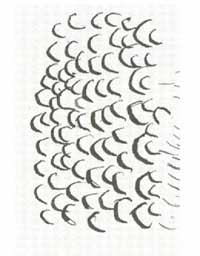
Cloud Shield Winter Count |
1840-41 --
"They stole many horses from the Snakes."
-- Cloud Shield Winter Count
The Cloud Shield Winter Count depicts the year 1840-41 with many horse tracks.
Encouraging Bear, an old friend and spiritual adviser to Crazy Horse, said that "Crazy Horse was born at the foot of Bear Butte in the year in which the band to which he belonged, the Oglalas, stole 100 horses" -- that would mean the fall of 1841 by the Cloud Shield Winter Count, although other calculations and comments by He Dog place Crazy Horse's birthdate as early as 1837-38.
|
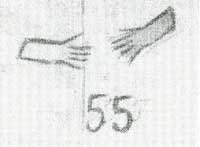
The Flame Winter Count |
"Red Arm, Cheyenne, and Lone Horn, a Dakota, make peace."
-- The Flame Winter Count
Momentous alliance between the Sioux and Cheyenne is sealed. For the next 40 years, the Sioux / Cheyenne alliance would be the axis of Native American resistance to the American invaders on the Great Plains.
|
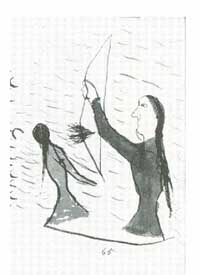
Cloud Shield Winter Count |
1841-42 --
"The Oglalas got drunk on Chug Creek and engaged in a quarrel among themslves."
-- Cloud Shield Winter Count
American Horse says it was a "drunken brawl." The Kiyuksa Band separated after this.
The Oglalas were one of the Seven Council Fires or bands that made up the Teton Dakota, or Western Sioux.
|
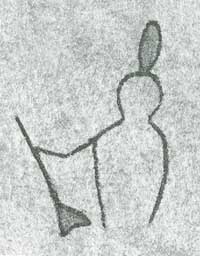
Lone Dog Winter Count |
1842-43 --
"One Feather raised a large war party against the Crows."
-- Lone Dog Winter Count
|
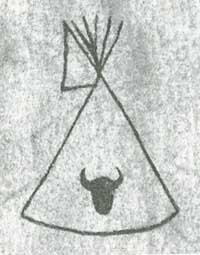
Lone Dog Winter Count |
1843-44 --
"Sans Arcs made medicine to bring the buffalo."
-- Lone Dog Winter Count
The Sans Arcs were one of the Seven Council Fires or bands that comprised the western Sioux or Teton Dakota.
|
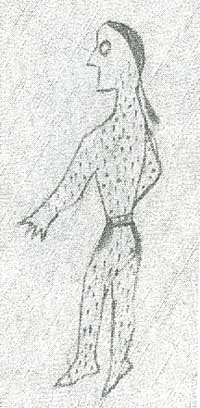
Long Soldier Winter Count |
1844-45 --
"Small pox year."
-- Long Soldier Winter Count
According to Kingsley M. Bray, Crazy Horse's mother, Rattle Blanket Woman, commited suicide in early 1845, after her husband -- Crazy Horse, the elder -- accused her of having an affair with a white man because of his son Crazy Horse's light, wavy hair and half-wasichu looks.
|
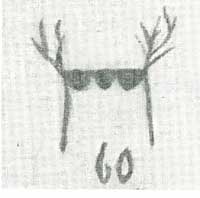
The Flame Winter Count |
1845-46 --
"Dakotas have much feasting at Ash Point, 20 miles above Fort Sully."
-- The Flame Winter Count
The glyph represents buffalo meat drying on a rack.
According to Kingsley M. Bray, the winter after Rattle Blanket Woman committed suicide, her son Curly Hair (the future Crazy Horse) rode through the village urging hungry people to come to his family's tent for food, which they did -- eating all his father had been able to secure for his own family. The next day when he complained of hunger, young Crazy Horse's father told him to "live up to your reputation."
|

The Flame Winter Count |
1846-47 --
"Broken Leg dies."
-- The Flame Winter Count
|
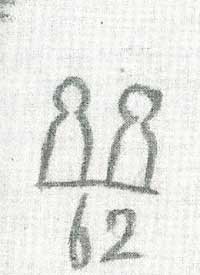
The Flame Winter Count |
1847-48 --
"Mandans kill two Minneconjous"
-- The Flame Winter Count
The Minneconjous were one of the Seven Council Fires or bands that made up the Teton Dakota, or Western Sioux.
|
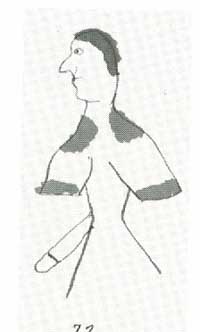
Cloud Shield Winter Count |
1848-49 --
"American Horse's father captured a Crow woman, who was really a hermaphrodite."
-- Cloud Shield Winter Count
|
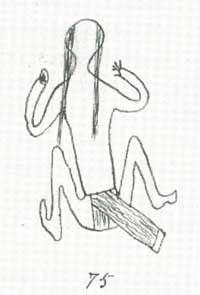
American Horse Winter Count |
1849-50 --
"Many died of the cramps."
-- American Horse Winter Count
|
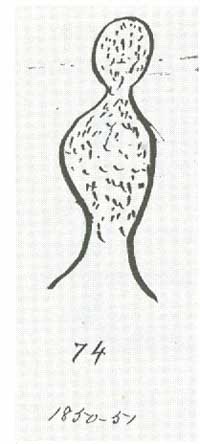
Cloud Shield Winter Count |
1850-51 --
"Many died of the smallpox."
-- Cloud Shield Winter Count
|
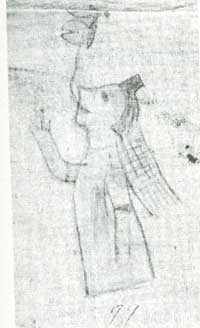
Rosebud Winter Count |
"They captured a Crow half-man and half-woman."
-- Rosebud Winter Count
On September 17, 1851, the United States and Sioux chiefs chosen by the United States signed the Horse Creek Treaty of 1851, whereby the Sioux allowed whites to cross their land on the Oregon trail in return for 50 years of annuity payments from the U.S. Government.
|
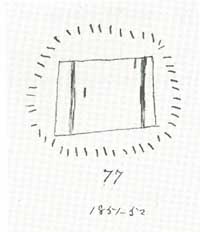
American Horse Winter Count |
1851-52 --
"They received their first annuities at the mouth of Horse Creek."
-- American Horse Winter Count
These were the first of the annuities due the Sioux for siging the Treaty of 1851.
According to his cousin Flying Hawk, the autumn of 1852 -- when he was 12 years old -- was when Crazy Horse first "began to fight enemies."
|
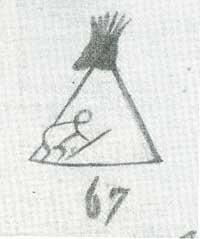
The Flame Winter Count
|
1852-53 --
"A Crow Chief, Flat Head, comes into the tipi of a Dakota Chief, where a council was assembled, and forces them to smoke the pipe of peace."
-- The Flame Winter Count
According to a famous incident recounted by Ohiyesa, young Crazy Horse saved his brother Little Hawk's life (not the last time) when he charged a grizzly bear with nothing but a lariat. Kingsley M. Bray places this event during the summer of 1853.
|
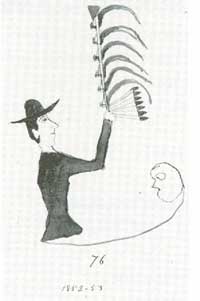
Cloud Shield Winter Count |
"A white man made medicine over the skull of Crazy Horse's brother."
-- Cloud Shield Winter Count
This white man could have been a grave robber, a curious tourist or a determined Christian interring a heathen Indian's bones in the Earth, goddamit, but whatever his motivation, his actions were deeply offensive to Crazy Horse and his father, the elder Crazy Horse (later called Worm), whose brother this probably was.
Americans have a long, compulsive history of descecrating Indian graves. A few days before the Battle of the Little Bighorn, for instance, George Custer had Isaiah Dorman, the black scout / interpreter for the Seventh Cavalry, tear down a Sioux grave scaffold. According to the Arikara Narrative, Dorman used the Indian corpse for fish bait. Before they finally killed him at the Battle of the Little Bighorn, the Sioux and Cheyenne tortured Dorman hideously.
On June 15, 1853, a group Minneconjou Sioux siezed the ferry over Platte River near Fort Laramie, and took the boat for a bit of a joy ride. That night, a U.S. Army contingent commanded by a hot-headed rascist named Lt. Hugh Flemming, stormed the Minneconjou village of Little Brave, with the intention of arresting the ferry-jackers. When he was unable to apprehend the culprits, he and his men murdered three other Indians and took two more as prisoners back to Fort Laramie. The Americans subsequently rewarded Flemming by promoting him acting commander at Fort Laramie, a position he held during the fateful events of the following summer.
|
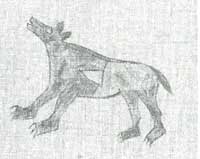
Long Soldier Winter Count |
1853-54 --
"Chief Brave Bear was killed."
-- Long Soldier Winter Count
Brave Bear was another name for Conquering Bear, a friendly Brule Sioux (and the first signatory of the Treaty of 1851) who was murdered by U.S. Army Lt. John Grattan in an argument over an old cow that had gotten away from a Mormon wagon train.
On August 19, 1854, acting Fort Laramie commander Lt. Hugh Flemming sent Grattan and 89 men to bring bovine justice to the Sioux, and the results were as explosive as they had been the year before at the Flemming Massacre, except this time the final score was different. After Grattan's men murdered Conquering Bear, the Sioux killed all the Americans. (A similar incident occurred in 1872, when white trader John Richard murdered an Oglala named Yellow Bear, and was himself cut down by the Sioux before he could get out of the Indian's lodge.)
The Sioux didn't know it at the time of Grattan Massacre, but the U.S. Government had already unilaterally cut the annuity payments due the Sioux for signing the Horse Creek Treaty of 1851 from 50 years to 15, thus reneging on over two-thirds of the agreed upon price due the Indians for letting the ever growing, increasingly insolent stream of whites to cross their land on the Oregon Trail.
On September 13, 1854 -- three days after Indian Agent Fiztpatrick returned to Fort Laramie with news of this latest American treachery -- a Sioux war party led by Spotted Tail, Red Leaf (Conquering Bear's brother) and Long Chin attacked the westbound stage coach near Cold Spring, twenty-four miles from Fort Laramie, killed the driver and the conductor and made off with $10,000 in gold.
Sioux reprisals for the Americans' murder of Conquering Bear continued into the spring of 1855. According to Douglas C. McChristian, "In February Sioux drove off sixty-five head of horses and mules from the Ward and Guerrier trading post eight miles above Fort Laramie. Thomas S. Williams reported that a large war party also stole stock from his party near Devil’s Gate, as well as all the animals belonging to the mail company and two other ranchmen at the same point. Mineconjou raiders subsequently scooped up four army mules just west of Fort Laramie early in May. Then in June at Deer Creek Crossing, Sioux warriors shot down Robert Gibson, leader of a wagon train from Missouri, as he was in the act of shaking hands with them. The same party attacked another group of emigrants at about the same place a few days later, lancing a man and a woman and running off some stock."
|

Battiste Good Winter Count |
1854-55 --
"Little Thunder and Battiste Good and others taken prisoner at Ash Hollow on the Blue Creek winter."
-- Battiste Good Winter Count
This entry refers to the Harney Massacre, where American troops under the command of Gen. William Harney murdered nearly 100 peaceful Sioux in "retaliation" for the Americans' murder of Conquering Bear the year before.
This deep American pattern -- where Americans commit atrocities against native peoples, and then "retaliate" with more atrocities -- was repeated at the Sand Creek Massacre and the Tongue River Massacre, and continues in the 21st century headlines from the American invasions of Afghanistan and Iraq.
On October 18, 1855, Spotted Tail, Red Leaf and Long Chin surrendered to American authorities at Fort Laramie, in order to win the release of the hostages Harney had taken at the Harney Massacre.
|
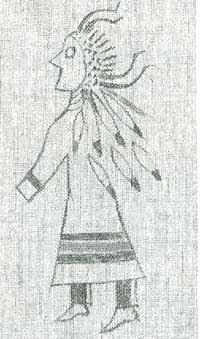
Long Soldier Winter Count |
1855-56 --
"Crow Indian has on a Sioux hat and is killed by Sioux."
-- Long Soldier Winter Count
Spotted Tail, Red Leaf and Long Chin began serving prison terms in the brig at Fort Laramie. By compaison, U.S. President Franklin Pierce and Congressional leaders did not serve prison terms for illegally abrogating the Treaty of 1851, which stole far more from the Sioux than the $10,000 Spotted Tail and his accomplices got in the Kincaid Coach Raid.
|
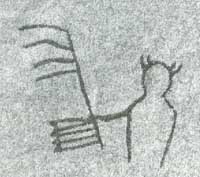
Lone Dog Winter Count |
1856-57 --
"Four-Horn was made a calumet or medicine man."
-- Lone Dog Winter Count
In May 1857, sixteen year-old Crazy Horse was part of a Sioux war party that attacked a Pawnee Village in what the Americans call eastern Nebraska. As the Sioux's fierce charge accelerated toward the enemy, Crazy Horse dashed out in front of all the rest, killing and counting coup on all sides. "From that time on," Eagle Elk remembered of Crazy Horse, "he was talked about."
On July 28, 1857, U.S. Army troops commanded by Edwin V. Sumner routed an estimated 300 Cheyenne warriors near the Cheyenne Village on the Saline River. According to Kingsley M. Bray, Crazy Horse was part of a small Sioux contingent that joined the Cheyenne that day and witnessed first- hand how an unexpected move by the charging Americans (who all drew their sabers in unison at 100 yards, something the Cheyenne had never seen before) could undo the fiercest enemy.
In August 1857, a Great Council of the Seven Campfires of the Teton Dakota was convened along the Belle Fourche River near Bear Butte in the Black Hills. With the exception of the imprisoned Spotted Tail, all the great Sioux chiefs were there, among them Four Horns and Sitting Bull from the Hunkpapas, Lone Horn from the Minneconjou, Old Man Afraid Of His Horse and Red Cloud from the Oglala.
Young Crazy Horse was there too, along with his whole family and thousands of other Sioux, to watch their leaders debate how to deal with the treacherous American invaders. Out of the Bear Butte Council came a joint resolution tersely paraphrased by Bear's Ribs, "they agreed together to hereafter let no one come." Acting on that resolution, Sioux warriors led by Bear's Ribs forcibly prevented a U.S. Army survey party commanded by Lt. Gouverneur K. Warren from crossing the Black Hills later that fall.
In September 1857, a few weeks after the Great Council at Bear Butte, Crazy Horse accompanied his friend and mentor, Hump, on a war party against the Arapahoes. When Hump and Crazy Horse made a brave charge along the Arapaho line, Hump's pony was shot out from under him and he would have died if Crazy Horse hadn't swooped him up and carried him to safety.
Later, Crazy Horse charged the Arapaho line "several times alone," and once he counted coup on a fallen Arapaho warrior who none of the other Sioux had been able to touch by turning the unexpected to his advantage this time: Horn Chips recalled how it seemed that Crazy Horse's pony "became unmanagemable" as he danced and twirled and stuttered his way through the buzzing bullets to the fallen Arapaho, but actually this was a trick Crazy Horse had taught his horse, just as he later taught his crack troops to fight like mounted light infantry when he ordered it.
When the war party returned, Crazy Horse's father -- Crazy Horse, the elder -- was so impressed that he bestowed the family name Crazy Horse on his son, and took the name Worm for himslef. Thereafter Curly Hair and His Horse In Sight were no more, and the Crazy Horse we know stepped onto the stage of world history.
|
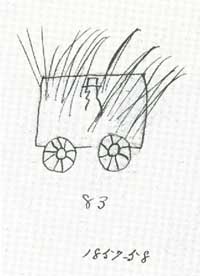
American Horse Winter Count |
1857-58 --
"Little Gay, a white trader, was killed by an exploding can of gun powder."
-- American Horse Winter Count
|
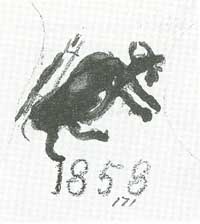
Battiste Good Winter Count |
"Hunted bulls only winter."
-- Battiste Good Winter Count
The Battiste Good Winter Count offers a dire sign that the buffalo herds' reproductive capacity was falling drastically, and a grim harbinger of the bison's near extinction at the hands of the Americans.
|
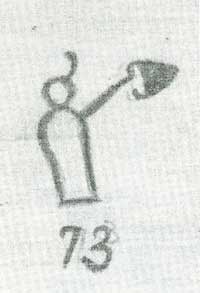
The Flame Winter Count |
1858-59 --
"Lone Horn makes medicine."
-- The Flame Winter Count
|
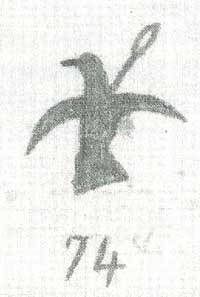
The Flame Winter Count |
1859-60 --
"Big Crow was killed."
-- The Flame Winter Count
In the early winter of 1859, Crazy Horse had a famously successful buffalo hunt. Killing ten bison cows single-handedly, he gave away all the meat except for the ten tongues, echoing a famous story of generosity from his youth.
According to Kingsley M. Bray's revisionist chronology, Crazy Horse had his famous dream vision of the flying horseman in the storm during the summer of 1860, not in the summer of 1854, as Mari Sandoz had it.
|
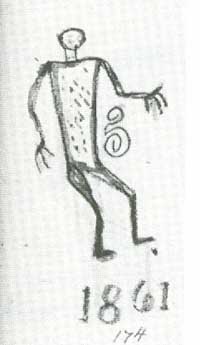
Battiste Good Winter Count |
1860-61 --
"Broke out with rash and died with pains in the stomach winter."
-- Battiste Good Winter Count
|
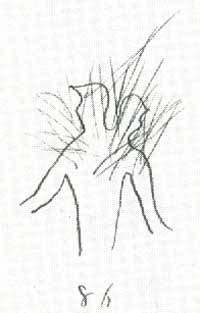
American Horse Winter Count |
"Two Face, an Oglala, was badly burnt by the explosion of his powder horn."
-- American Horse Winter Count |
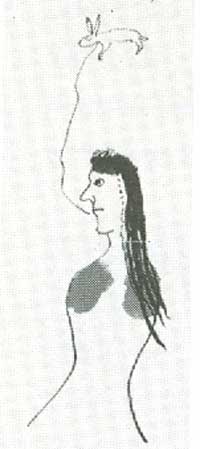
Cloud Shield Winter Count |
1861-62 --
"Young Rabbit, a Crow, was killed in a battle by Red Cloud."
-- Cloud Shield Winter Count
Five years later, Red Cloud would prove the most strategically successful Indian leader in American history when he defeated the U.S. Army and forced the United States to recognize the Sioux's exclusive and perpetual claim to the Blacks Hills, as set forth in the Treaty of 1868.
This glyph represents the man Red Cloud killed, whose identity is revealed by the line to the rabbit drawn above his head, and whose death is indicated by the large blood stains on his torso.
Crazy Horse had another vision in 1862. According to Kingsley M. Bray, "as the onset of cold weather curtailed raiding in fall 1862, Crazy Horse confided in Horn Chips about another new vision. This time he had dreamed of the Rock. Perceived as the primal element of the universe, the oldest of the four manifestations of Wakan Tanka, Rock was unique -- the only thing in nature that is not round, a manifestation not of the generative assurance of the circle, but jagged, irruptive, of fearsome strength and eternal endurance."
It was probably during the summer of 1862 that Crazy Horse and his younger brother, Little Hawk, first rode together on a war party. According to Eagle Elk, the target of the Sioux raiders was a Ute village in what the Americans call northern Colorado. Among the Utes was a particularly fierce warrior who killed several Sioux warriors and could not be bested until Crazy Horse killed him, and then let Little Hawk count first coup on the fallen Ute hero.
Meanwhile, further east, in the realm of the Santee Sioux, war with the Americans flared. Frustrated with America's unwillingness to honor its treaties obligations -- particularly regarding annuity payments due the Minnesota Sioux for signing treaties with the U.S. -- warriors led by Santee Sioux Little Wolf killed an estimated 400 whites Americans on August 18, 1862, the first day of the Minnesota Sioux Uprising. One of these was a hated American merchant -- Andrew Myrick -- who had recently turned down some Indians' request for credit while awaiting their over-due annuity payments with the comment, "let them eat grass." Myrick was found dead, his mouth stuffed with prairie grass.
After defeating the Little Crow's Sioux force at Wood Lake, the Americans hung 38 Sioux warriors simultaneously on a common scaffold in Mankato, MN, the day after Christmas 1862, despite a plea for clemancy to President Abraham Lincoln by Episcopal Bishop Henry B. Whipple: "I ask," Whipple wrote, "that the people shall lay the blame ... where it belongs, and ... demand the reform of an atrocious Indian system which has always garnered for us ... anguish and blood."
|
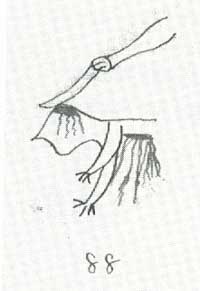
American Horse Winter Count |
1862-63 --
"Crows scalped an Oglala boy alive."
-- American Horse Winter Count
Along with Young Man Afraid Of His Horse, He Dog and Kicking Bear, Crazy Horse distinguished himself against the Crows in The Battle Defending The Tents. Kingsley M. Bray dates this engagement in the summer of 1863. According to William J. Bordeaux, Crazy Horse was part of a combined Oglala / Minneconjou raiding party that stole 300 horses during the summer 1863.
There were a few after-shocks of the Minnesota Sioux Uprising during the summer of 1863, but the Santee Sioux had been crushed in their homeland, and those among them who wanted to live free from the American invaders' yoke -- like Inkpaduta -- headed west, into the land of Teton Sioux, where they helped fuel an increasing militancy against the treacherous Americans, that became apparent the following summer.
|
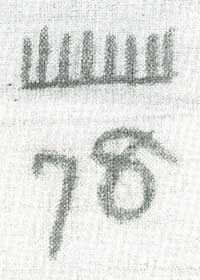
The Flame Winter Count |
1863-64 --
"Crows killed eight Dakotas on the Yellowstone."
-- The Flame Winter Count
On July 12, 1864, Sioux raiders attacked the Larimer Party, killing several in the wagon train and taking three white women prisoner.
On August 7, 1864, Sioux and Cheyenne raiders attacked American settlements "with military precision" along a 250 mile front from Julesburg, CO, east to Liberty Farm Station on the Little Blue River. At Liberty Farm Station, the Indians destroyed $22,000 worth of freight, killed everyone in the station, then scalped and killed a local rancher, Joesph Eubank, in front of his wife and infant daughter, before carrying mother and child with them into capivity.
On November 29, 1864, Colorado Volunteer Militia troops under the command of the good Christian, Parson John Chivington, retaliated by murdering more than 100 friendly Cheyenne in the camp of Black Kettle, many of them women, children and elderly. Believing themselves under the protection U.S. Army troops at nearby Fort Lyon, the Indians were unprepared for attack and completely sucker-punched by the Colorado Volunteers at the Sand Creek Massacre.
|
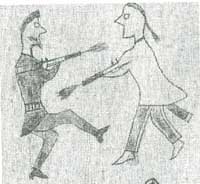
Long Soldier Winter Count |
1864-65 --
"First fight with white men."
-- Long Soldier Winter Count
This was not Sioux's first warfare against whites, of course, but rather the outbreak of the Sioux Indian War of 1865, which predictably followed the atrocities of the Colorado Volunteers at the Sand Creek Massacre in late 1864.
The Sioux and Cheyenne brought war to Colorado quickly. According to The Life and Death of Crazy Horse by Russell Freedman, Crazy Horse fought at Julesburg, CO, on January 7, 1865, when an Indian war party estimated at 1,000 or more attacked the westbound stage coach and then killed more than a dozen 7th Iowa Volunteer Cavalry troopers snared in the well-crafted Indian trap. Less than a month later, on February 2, 1865, the Indians returned and burned most of old Julesburg to the ground.
On May 6, 1865, the U.S. Army commander at Ft. Laramie, Col. Thomas Moonlight, summarily hung Sioux headmen Two Face and Blackfoot, who had been "captured" while trying to return Mrs. Eubank to the Americans at Fort Laramie. The chained bodies of Two Face and Blackfoot hung on the gallows at Fort Laramie until one observer said they resembled Egyptian mummies. Mrs. Eubank testified that "the whole village ravished" her, but by comparison, neither George A. Custer nor his brother Thomas Custer was hung in chains when one of them fathered Yellow Tail by Monaseetah while she was a prisoner of the U.S. Army. Col. Moonlight's actions made the hypocrisy and savage cruelty of American "justice" utterly clear to the free Sioux and Cheyenne.
Once again, the Indians' response was quick and violent. As Douglas C. McChristian recounted the staccato bark of rising violence in Fort Laramie and the U. S. Army On the High Plains 1849 - 1890: "May 20, a force of two hundred warriors descended on the station at Deer Creek with the intent of stealing the stock there, but the Kansas veterans put up a determined resistance. The raiders managed to kill one soldier and escape with twenty-two horses, but the raid cost them seven warriors killed and one wounded. Lieutenant Colonel Preston B. Plumb gave chase with thirty troopers, but was unable to ford the river. Demonstrating their contempt for the soldiers, another party stole several mules within just eight miles of Fort Laramie. A detachment of forty cavalrymen took up their trail and recaptured the animals. A few days later, Indians interrupted communications when they tore down sixteen miles of telegraph line between Horseshoe Station and La Bonte Creek, and shortly afterward a war party attacked and burned St. Mary's Station. Indians stampeded the herd at Sweetwater Crossing on May 26, though they were prevented from getting away with the animals when troopers of the Eleventh Ohio opened a brisk fire on them with their Spencer rifles. That same day, warriors boldly attacked a government supply train, escorted by an entire company of soldiers, nine miles below Platte Bridge. Farther east, Indians stole a number of animals from the Overland Stage Line near North Platte."
On May 14, 1865, First Sergeant Isaac B. Pennick, Company I, Eleventh Kansas Cavalry, jotted in his diary: "Indians have burned all ranches west of Cache la Poudre to Platte River on Denver side."
The U.S. Army then ordered the Reservation Sioux marched to Fort Kearney, NE, about 300 miles east in the midst of their traditional enemies, the Pawnee. To prevent what they saw as a suicidal move, the Reservation Sioux begged their free brethren for help. Their call was answered by a war party of free Sioux that rode south on June 13, 1865. Crazy Horse was a part of that force, but before they could attack, the Reservation Sioux staged their own maneuver, killing the American solders' commanding officer, Capt. William D. Fouts, and escaping on their own.
On July 26, 1865, when U.S. Army troops commanded by Lt. Caspar Collins were lured into a trap near the Platte River Bridge and attacked by a Sioux / Cheyenne force that included Crazy Horse and the Cheyenne war chief Roman Nose. Collins was killed by an arrow through the forehead, but some of his men managed to cut through the encircling Sioux / Cheyenne line and escape the Battle of the Platte River Bridge with their lives.
The five-wagon supply train that Collins's battalion had been riding out to meet was not so fortunate. The Indians killed Sergeant Amos Custard and his 19 men, and then burned the wagons. "We could see the Indians in swarms charge down upon our boys, when they would roll volley after volley into them," wrote First Sergeant Isaac B. Pennick, Company I, Eleventh Kansas Cavalry, in his diary. "It seemed to us as though the boys were in a strong position, 20 in all being the number. At about 4 o'clock p.m. the firing ceased, and the smoke, that of the burning wagons, commenced ascending. The enemy commenced going off north by twos and threes, till at sundown not a living being was to be seen."
According to Kingsley Bray, in the summer of 1865 "Crazy Horse led another war party against the garrison [Camp Connor], harrying stragglers and stealing stock: eleven-year-old Red Hawk, son of the intransigent warrior who had deserted the Hunkpatilas in 1853, served as water-boy apprentice and proudly recalled his first war party under Crazy Horse's leadership. [Red Hawk in Edward Curtis, Teton Sioux, p 188]"
The response of the American invaders was bluntly genocidal. Gen. Patrick E. Connor told his troops: "You will receive no overtures of peace or submission from the Indians, but will attack and kill every male Indian over twelve years old."
On August 29, 1865, Connor's troops attacked a peaceful, unsuspecting Arapaho village on the Tongue River, killing a reported 63 Indians, burning 250 lodges, and capturing 500 ponies. The Tongue River Massacre -- another American sucker-punch of friendly Indians, like the Grattan Massacre, the Blue Water Massacre, and the Sand Creek Massacre -- proved the Americans' most successful moment in the war.
Less than a week later, in early September 1865, the U.S. Army fought a series of engagements with the real "hostiles" -- the free Sioux and Cheyenne -- that are collectively termed the Powder River Campaign of 1865.
At the battle on September 5, 1865, Crazy Horse and Roman Nose again distinguished themselves for bravery, each riding the length of the American soldiers' defensive line without getting hit.
And at the battle on September 11, 1865, Red Cloud led a brilliant rear-guard action that successfully covered the retreat of the Indians' main village, after which the Americans' 1865 invasion of the Great Sioux Nation collapsed.
According to Kinglsey Bray, Crazy Horse paid his last friendly visit to the Fort Laramie area in early 1865.
|
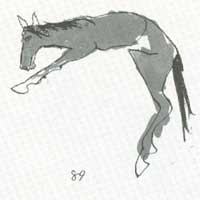
Cloud Shield Winter Count |
1865-66 --
"Many horses lost to starvation."
-- Cloud Shield Winter Count
|
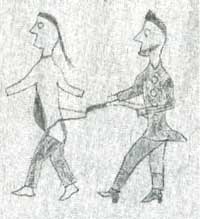
Long Soldier Winter Count |
1866-67 --
"Gall was stabbed by soldiers and brought back from Cannon Ball by soldier."
-- Long Soldier Winter Count
Regarding the Fetterman Massacre, Dr. Charles Eastman (Ohiyisa) wrote that in December 21, 1866 "the Sioux advanced upon Fort Phil Kearny, the new sentinel that had just taken her place upon the farthest frontier, guarding the Oregon Trail. Every detail of the attack had been planned [by Red Cloud] with care, though not without heated discussion, and nearly every well-known Sioux chief had agreed in striking the blow. The brilliant young war leader, Crazy Horse, was appointed to lead the charge. His lieutenants were Sword, Hump, and Dull Knife, with Little Chief of the Cheyennes, while the older men acted as councilors. Their success was instantaneous. In less than half an hour, they had cut down nearly a hundred men under Captain Fetterman, whom they drew out of the fort by a ruse and then annihilated."
According to the Wagon Box Fight Interpretive Signs at the Wagon Box Memorial Site about 5 miles northwest of Fort Phil Kearny, in the Wagonbox Fight on August 2, 1867, "Crazy Horse and Hump led a small number of warriors across the hills to the west in a decoy attack on the Little Piney Camp. Here three soldiers are killed and the remaining wood cutters are chased into the mountains.
"This attack is followed by attacks on the wood train at the upper pinery, and the mule herd.
"Soldiers, drivers and wood cutters from the wood train and pinery escape into the mountains, but the mule herd is captured. Powell leads an attack to rescue the herders, as outlying sentries and hunters from the fort make for the safety of the corral. By nine o’clock 26 soldiers and six civilians are surrounded in the corral facing, by Powell’s estimate, 800 to 1000 warriors."
According to William J. Bordeaux, "in 1867, following the Fort Phil Kearney battle, he [Crazy Horse] became a member of a Sioux war-party that raided a wagon train on the Tongue River. Capturing the entire caravan the raiders discovered that the wagons were loaded mostly with blankets. On this occasion Crazy Horse selected a scarlet one for himself and wore it thereafter until the time of his death."
|
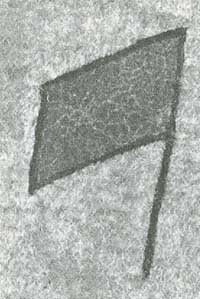
Lone Dog Winter Count |
1867-68 --
"Many flags were given them by the Peace Commission."
-- Lone Dog Winter Count
According to the Diocese of Cheyenne website, "In 1868, Crazy Horse and about 60 Sioux warriors attacked old Horseshoe station and burned it to the ground in a three-day battle which stretched from Sibley Peak to the hills south of the Cassa Flats.
According to He Dog, Crazy Horse was made a shirt wearer, a lance-bearer of the Kangi Yuha (Crow Owners' Society). |
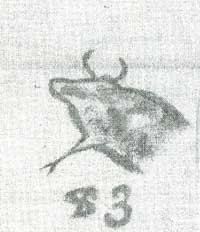
The Flame Winter Count |
1868-69 --
"First issue of beef by the government to Indians."
-- The Flame Winter Count
|

Long Soldier Winter Count |
"A French man, named Red Walker, came here all alone and brought gun powder and sold to Indians."
-- Long Soldier Winter Count |
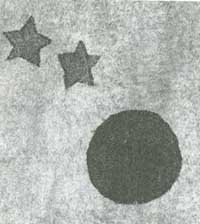
Lone Dog Winter Count |
1869-70 --
"An eclipse of the sun."
-- Lone Dog Winter Count
In the summer of 1870, about ten days after the battle "When They Chased The Crows Back To Camp," Crazy Horse ran off with Black Buffalo Woman, who was married at the time to another Oglala, No Water. No Water followed the lovers and two days later on the Powder River, he burst in on them and shot Crazy Horse point blank in the face. Crazy Horse survived, but his left cheek was scarred for life. |
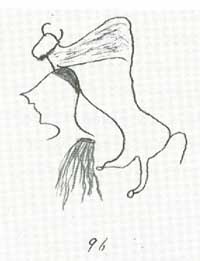
American Horse Winter Count |
1870-71 --
"High Backbone, an Oglala, was killed by the Shonshoni."
-- American Horse Winter Count
He Dog said another repurcussion of Crazy Horse's affair with Black Buffalo Woman was that he had to resign his position as shirt wearer.
A few months after Black Buffalo Woman returned to No Water, she "gave birth to a light-haired little girl. Many people believe this child was Crazy Horse's daughter, but it was never known for certain."
High Backbone or Hump the elder was a close friend of Crazy Horse's, and they were together when Hump was killed. Crazy Horse advised against attacking the Shonshoni that afternoon, but Hump insisted, despite their tired horses and the chill, sleety weather. Here is He Dog's eye-witness account of the events surrounding the death of Hump. Here is Red Feather's eye-witness account.
Hump the elder should not be confused with the younger Hump (possibly a nephew of the elder), who fought at Battle of the Little Bighorn.
|
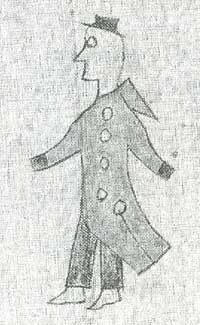
Long Soldier Winter Count |
"Another party of 10 Frenchmen came and traded with the Indians."
-- Long Soldier Winter Count
Crazy Horse and Black Shawl Woman were married in 1871, according to Black Shawl Woman's brother, Red Feather.
|
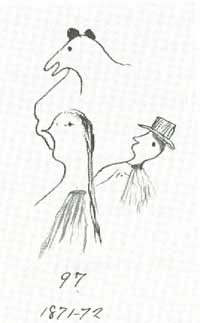
American Horse Winter Count |
1871-72 --
"John Richard shot and killed an Oglala named Yellow Bear; Oglalas then killd Richard."
-- American Horse Winter Count
In an incident which echoes the Grattan Massacre nearly 20 years before, white trader John Richard was killed by the Oglalas before he could get out Yellow Bear's lodge.
On August 14, 1872, Sitting Bull and Crazy Horse led a large Sioux / Cheyenne force to a resounding strategic victory over the American invaders at the Battle of Arrow Creek, where the Indian show of force terrified all the railroad workers into quitting and catching the first train East, thereby blocking further American expansion into the Yellowstone Valley.
Crazy Horse and Black Shawl Woman's only child, a daughter named They Are Afraid Of Her, was born.
|
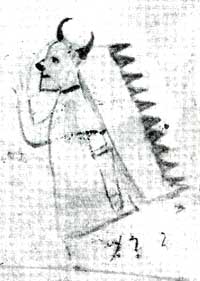
Rosebud Winter Count |
1872-73 --
"Bull Head made a ceremony."
-- Rosebud Winter Count
Taken together, these two very different entries indicate how divided the Sioux world had become by 1872-3, with one portion -- the so-called Loafers -- living off American alms (as depicted by Battiste Good), and the other -- the free Sioux and Cheyenne -- pursuing the traditional life (as depicted by Rosebud at left). |
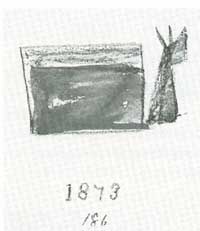
Battiste Good Winter Count |
"Issue year winter."
-- Battiste Good Winter Count
Battiste Good's glyph shows a trade blanket next to a tipi.
According to The Arikara Narrative, Goes Ahead "recalls that about 1873 a party of white men went through his country fighting with the Dakotas. They had pack-horses, picks, and shovels. They were fine shots and killed many of the Dakotas and took scalps. They wore war-bonnets and they gave some to the Crows, who were friendly. Among the men were four called Yellow Mule, Crooked Nose, Big Nose, Liver Eater. The two first named talked the Crow language very well and they were trappers and hunters in the Crow country."
Along with freelance American mauraders came the official treaty violators of the American government. In the summer of 1873, David S. Stanley led an illegal American expedition of 1500 troops into Sioux territory. George A. Custer was one of the officers under Stanley, and on August 4 near the mouth of the Tongue River, Custer and Crazy Horse met for the first time. Around noon, Crazy Horse caught Custer napping -- Custer was literally asleep, and responded to the first shots in his underwear -- but the Sioux and Cheyenne lacked sufficient strength to do more than steal some of the Americans horses before disengaging. |

Battiste Good Winter Count |
1873-74 --
"Measles and other sickness used up the people in winter."
-- Battiste Good Winter Count
The Americans followed up the Stanley Expedition of the prior year with the even larger Black Hills Expedition of 1874, led this time by George Custer, whose dispatches from the field touched off the Black Hills gold rush. "There is no doubt as to the existence of various metals throughout the hills," Custer wrote to Assistant Adjuntant General of Dakota, August 15, 1874. "As this subject has received the special attention of experts who accompanied the expedition, and will be reported unpo in detail, I will only mention the fact that iron and plumbago have been found and beds of gypsum of apparently inexahustible extent. I referred in a former dispatch to the discovery of gold. Subsequent examinations at numerous points confirm and strengthen the fact of the existence of gold in the Black Hills."
Crazy Horse and Black Shawl Woman's beloved infant daughter, They Are Afraid Of Her, died of cholera at age two as white diseases wracked the Plains Indians. That winter was a particularly hard one for the Sioux and Cheyenne. |
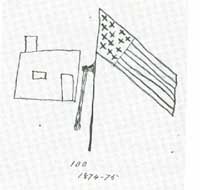
American Horse Winter Count |
1874-75 --
"The Oglalas at Red Cloud Agency cut up the flagpole."
-- American Horse Winter Count
The Sioux refused to allow the American flag to be flown over the Red Cloud Agency.
|
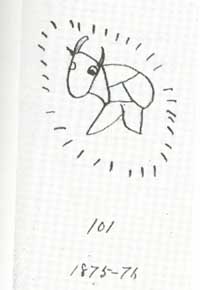
American Horse Winter Count |
1875-76 --
"First stock cattle were issued to them."
-- American Horse Winter Count
The big events of 1876 were actually the Battle of the Greasy Grass -- or the Little Bighorn, as the American invaders called it -- and the Battle of the Rosebud, which set it up.
Crazy Horse was commander-in-chief of the combined Sioux / Cheyenne force that resoundingly defeated Gen. George Crook on the Rosebud on June 17, 1876. After the battle, Lt. Henry Lemly reported that some of Crook's own men said he had been "outgeneralled" by Crazy Horse.
Then, eight days later, Crazy Horse played a pivotal role in annihilating the Seventh Cavalry, twice leading charges that shattered the defensive lines of Reno and then Custer. At the Little Bighorn, Arapaho warrior Waterman said Crazy Horse was the bravest man he ever saw.
American Horse's Winter Count doesn't reflect any of this because he was not at the Battle of the Little Bighorn, and Indians generally (whether they were on the Reservation or not) did everything possible to distance themselves from the battle in order to prevent American reprisals.
|
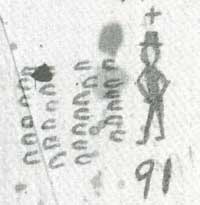
The Flame Winter Count |
1876-77 --
"Horses taken by U.S. Government."
-- The Flame Winter Count
White Cow Killer called it "General Mackenzie took Red Cloud Indians' horses away from them winter."
|
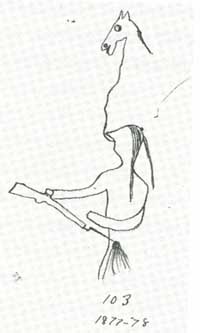
American Horse Winter Count |
1877-78 --
"Crazy Horse was killed."
-- American Horse Winter Count
Here is Red Feather's account of the events leading up to Crazy Horse's surrender on May 6, 1877, less than a year after his victories at the battles of the Rosebud and Little Bighorn.
Here is Billy Garnett's eye-witness account of the events leading up to the U.S. Army's murder of Crazy Horse while he was in "protective custody."
|
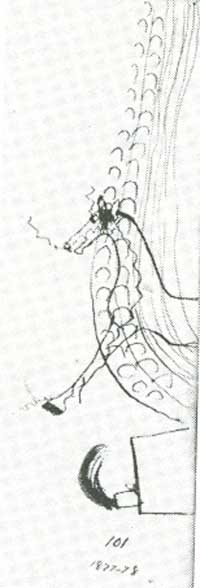
Cloud Shield Winter Count |
"Crazy Horse's band left the Spotted Tail Agency and went north, after Crazy Horse was killed at Fort Robinson, Nebraska."
-- Cloud Shield Winter Count
In this glyph by Cloud Shield, hoof prints lead away from the house with chimney at the bottom, which represents the Spotted Tail Agency. Crazy Horse is depicted as the primordial Sioux power of Thunder in the form of a horse with lightning at its nose and feet.
Red Feather said Crazy Horse's father, Worm, hid his body so that no one else knew where he was buried.
|
|
|
Updated November 30, 2010
The Year The Stars Fell: Lakota Winter Counts at the Smithsonian edited by Candace S. Greene and Russell Thornton, The Smithsonian Institution, Washington, DC, 2007 p 208 - 278
For more information on Crazy Horse, please see Crazy Horse at the Little Bighorn and Crazy Horse at the Rosebud, the Bogus Crazy Horse Photo page and The Crazy Horse Surrender Ledger, and the Chicago Times' coverage of Crazy Horse's surrender.
The Sioux chief American Horse who made these Winter Counts is not the Cheyenne war chief American Horse. American Horse the Cheyenne fought at the Battle of the Little Bighorn, while Sioux chief American Horse did not.
|





|



























































